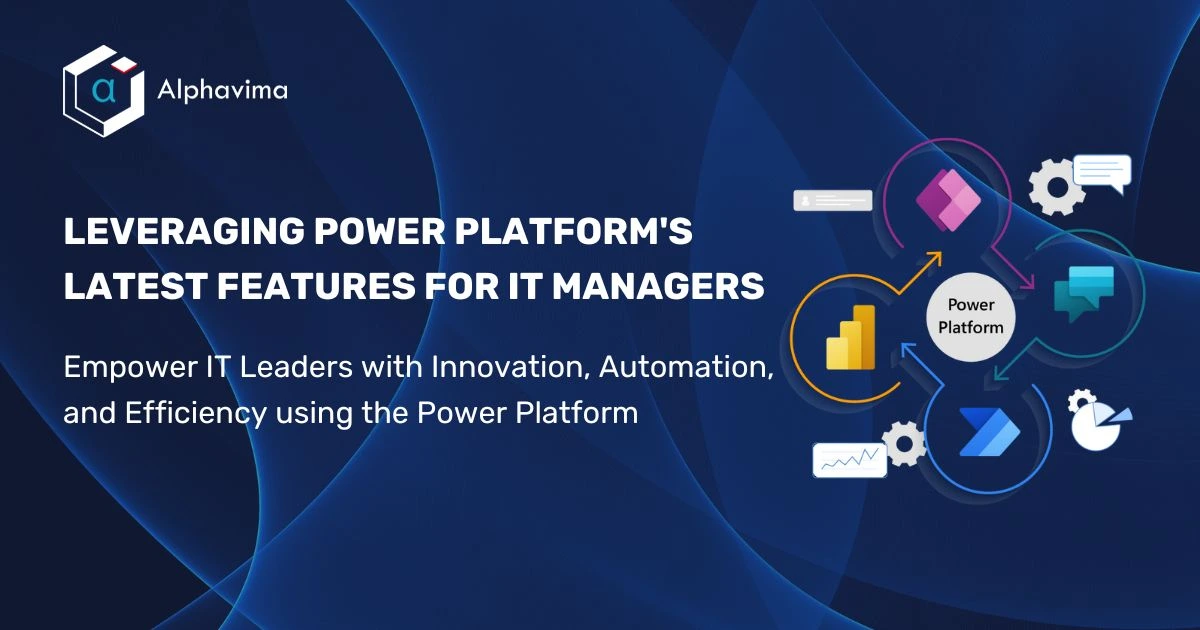Blog
Leveraging the Power Platform's Latest Features for IT Managers
03 Jan 2024

In today's fast-changing business world, IT managers want quick and effective solutions for complex problems. The Power Platform is a game-changer, giving IT leaders different apps and services to innovate, automate tasks, and boost productivity.
Understanding the Power Platform
The Power Platform is a robust suite comprising Power BI, Power Apps, Power Automate, and Power Virtual Agents. It integrates seamlessly with Microsoft 365 and Azure, enabling IT professionals to create custom applications, automate workflows, derive insights from data, and build chatbots, all without extensive coding.
Power Apps empowers IT managers in several crucial ways:
- Rapid Development: Its low-code/no-code interface accelerates application development, enabling teams to quickly address specific business requirements.
- Collaboration Enhancement: By integrating data from diverse sources, it fosters cross-departmental collaboration while ensuring data integrity and coherence.
- Efficiency Boost: Streamlining processes through digital form digitization, automated approvals, and enabling remote team access significantly enhances operational efficiency.
Power BI facilitates insightful decision-making by:
- Data Visualization: Transforming raw data into visually appealing, interactive dashboards aids in extracting actionable insights from complex datasets.
- Real-time Analytics: Monitoring key metrics in real-time enables proactive decision-making and the identification of emerging trends for IT leaders.
- Predictive Analysis: Leveraging advanced analytics and AI, it predicts trends and anticipates future business needs, enabling proactive strategies.
Automating Workflows with Power Automate
IT managers benefit from:
- Workflow Automation: Automating repetitive tasks reduces manual intervention, enhancing operational efficiency and freeing up resources for more critical tasks.
- Integration Capabilities: Seamlessly connecting disparate systems creates a cohesive workflow ecosystem, streamlining operations across the organization.
- Notifications and Alerts: Setting up alerts for critical events ensures timely actions, improving responsiveness and overall performance.
Enhancing Customer Interaction via Power Virtual Agents
- Chatbot Development: AI-powered chatbots efficiently handle customer queries, automating responses and improving overall customer service.
- Natural Language Understanding: Leveraging advanced language capabilities enhances the chatbot's effectiveness in understanding and responding to varied customer queries.
- 24/7 Availability: Offering round-the-clock support increases customer satisfaction and engagement, ensuring support availability at any time.
Statistics Highlighting Power Platform's Impact
- Forrester Consulting Study: Organizations using Power Platform saw a 188% ROI over three years, showcasing its substantial value and impact on businesses.
- Microsoft's Reported Revenue: Power Platform contributed to over $13.7 billion in estimated annual revenue for Microsoft's partners, emphasizing its widespread adoption and financial impact.
Future Prospects and Evolving Features
As the Power Platform advances, upcoming features are poised to revolutionize its functionality:
- AI-Driven Innovations: The platform's evolution will witness heightened AI capabilities, enabling predictive analysis for forecasting future trends. This enhancement will delve deeper into data, providing more profound and actionable insights crucial for strategic decision-making.
- Improved Integration: The roadmap includes seamless integration with a wider spectrum of third-party applications. This expanded compatibility will significantly broaden the platform's functionality, allowing for a more interconnected and versatile ecosystem.
- Enhanced Security Measures: As data security remains paramount, forthcoming updates will bolster security protocols. These strengthened measures will fortify data protection, ensuring compliance with evolving regulatory standards and fostering greater trust among users.
Implementing the Power Platform: Best Practices
For IT leaders navigating the adoption of the Power Platform, key best practices are instrumental:
- Start Small, Scale Fast: Initiating with targeted pilot projects enables a comprehensive understanding of the platform's capabilities. This approach minimizes risks, identifies challenges early, and lays a solid foundation for successful scaling across the organization.
- Training and Support: Providing robust training programs and continuous support to employees is pivotal. This empowers them to leverage the platform effectively, maximizing its potential and fostering a culture of proficiency and innovation.
- Continuous Improvement: Cultivating a culture of perpetual enhancement is fundamental. Iteratively refining applications and workflows based on user feedback and evolving business needs ensures ongoing optimization and aligns the platform with the dynamic demands of the organization. This iterative approach promotes agility, allowing adaptations that drive efficiency and innovation continually.
Conclusion
The Power Platform holds incredible potential for change. Its tools help IT managers simplify operations and improve customer interactions effortlessly. With AI, smooth integration, and strong security, embracing this platform isn't just a choice—it's a smart move toward a future-ready organization. Start with small steps, invest in training, and keep improving to unleash its full power and achieve lasting success in the digital age.
